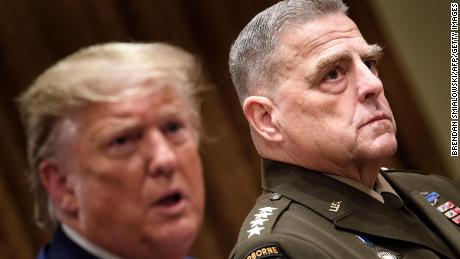The scheme put forward by controversial lawyer John Eastman was outlined in a two-page memo obtained by the authors for “Peril,” and which was subsequently obtained by CNN. The memo, which has not previously been made public, provides new detail showing how Trump and his team tried to persuade Pence to subvert the Constitution and throw out the election results on January 6.
The effort to sway Pence was just one of several behind-the-scenes attempts that Trump’s team undertook ahead of January 6 in a desperate bid to overturn the 2020 election loss, after dozens of lawsuits were thrown out of the courts. “Peril,” which will be released Tuesday, details how Eastman’s memo was sent to GOP Sen. Mike Lee of Utah and how Trump attorney Rudy Giuliani tried to convince fellow Republican Sen. Lindsey Graham of South Carolina of election fraud. But both Lee and Graham scoffed at the arguments and found they had no merit.
“You might as well make your case to Queen Elizabeth II. Congress can’t do this. You’re wasting your time,” Lee said to Trump’s lawyers trying to overturn the results in Georgia, according to the book.
The Eastman memo laid out a six-step plan for Pence to overturn the election for Trump, which included throwing out the results in seven states because they allegedly had competing electors. In fact, no state had actually put forward an alternate slate of electors — there were merely Trump allies claiming without any authority to be electors.
Under Eastman’s scheme, Pence would have declared Trump the winner with more Electoral College votes after the seven states were thrown out, at 232 votes to 222. Anticipating “howls” from Democrats protesting the overturning of the election, the memo proposes, Pence would instead say that no candidate had reached 270 votes in the Electoral College. That would throw the election to the House of Representatives, where each state would get one vote. Since Republicans controlled 26 state delegations, a majority could vote for Trump to win the election.
The plan was first proposed to Pence when Eastman was with Trump in the Oval Office on January 4, during one of Trump’s attempts to convince Pence that he had the authority to stop the certification of the election.
“You really need to listen to John. He’s a respected constitutional scholar. Hear him out,” Trump said to Pence at that meeting, Woodward and Costa write in “Peril.”
In the memo, Eastman went so far as to suggest Pence should take action without warning.
“The main thing here is that Pence should do this without asking for permission — either from a vote of the joint session or from the Court,” Eastman wrote. “The fact is that the Constitution assigns this power to the Vice President as the ultimate arbiter. We should take all of our actions with that in mind.”
In the end, Pence didn’t go along with Eastman’s scheme, concluding that the Constitution did not give him any power beyond counting the Electoral College votes. He did his own consultations before January 6, according to the book, reaching out to former Vice President Dan Quayle and the Senate parliamentarian, who were both clear in telling him he had no authority beyond counting the votes.
When Pence refused to intervene, Trump turned on his vice president, attacking him on Twitter even as the insurrection at the Capitol was unfolding on January 6.
The memo could be of interest to the House select committee now investigating the January 6 attack on the Capitol, which recently requested documents from the National Archives that specifically included communications involving Eastman.
“It shows intent, a sophisticated plan, a blueprint to illegally and unconstitutionally overturn and steal the election” by Trump and his team based on false and misleading information and legal arguments, a source familiar with the investigation told CNN.
‘Lee’s head was spinning’
Eastman spoke at the January 6 rally that preceded the attack on the Capitol. He retired from his position as a professor at Chapman University a week after January 6, which occurred amid protests from faculty at the Southern California university over his participation in Trump’s efforts to overturn the election.
Eastman told the Washington Post that his memo merely “explored all options that had been proposed.” CNN has contacted Eastman for comment through the Claremont Institute, where he is a senior fellow.
As part of the efforts of Trump’s team to convince Congress not to certify the election, the Eastman memo was given to Lee, one of the Senate’s top Republican constitutional authorities. At the same time, Giuliani sent multiple memos to Graham trying to convince him that the claims of election fraud coming from Trump’s team were legitimate.
The memos show how even some of Trump’s closest allies balked at the measures Trump’s team was taking behind the scenes to try to overturn his loss to Biden. But while Lee and Graham heard out the cases from Trump’s lawyers, they soundly rejected their claims, Woodard and Costa write.
Lee was shocked by the claims the memo was making, since no state had considered, let alone put forward, any alternate slates of electors. “Lee’s head was spinning,” the authors write. “No such procedure existed in the Constitution, any law or past practice. Eastman had apparently drawn it out of thin air.”
Lee also dismissed the Trump team’s arguments that it had a case to overturn the election results in Georgia, saying they had to be made in court.
‘Third grade’
Woodward and Costa also obtained several memos Giuliani sent to Graham to try to convince him of election fraud in Georgia and other states. CNN has also obtained those memos.
The authors write that on January 2, Giuliani briefed Graham at the White House. Giuliani presented a statistical analysis arguing Biden’s win was impossible, but Graham dismissed Giuliani’s evidence as too abstract. “Give me some names. You need to put it in writing. You need to show me the evidence,” Graham said, according to the book.
Giuliani then sent Graham several memos and affidavits claiming fraud. But when Graham’s chief Judiciary Committee counsel Lee Holmes went over the claims, he found they were sloppy, overbearing and “added up to nothing,” Woodward and Costa write. “Holmes reported to Graham that the data in the memos were a concoction, with a bullying tone and eighth grade writing.”
“Third grade,” Graham responded, according to the book. “I can get an affidavit tomorrow saying the world is flat.”
Giuliani did not respond to a request for comment.
Trump has continued to push baseless claims that the election was stolen from him. Last week, he sent a new letter to Georgia Secretary of State Brad Raffensperger claiming he should start the process of decertifying the 2020 election.
Criminal investigators in the state have been investigating Trump’s efforts to overturn Georgia’s 2020 election results, including an infamous call Trump made to Raffensperger in which Trump urged the secretary of state to “find” more than 11,000 votes that Trump needed to win.
Graham also made a phone call to Raffensperger, which is part of the Fulton County district attorney’s probe. Graham has said his call was to understand the process of verifying signatures on mail-in ballots.





